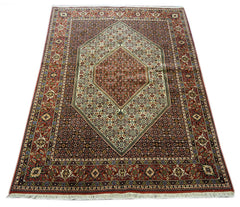Bijar Rugs – The Iron Rug of Persia
Bijar rugs are an interesting style of rugs known for having incredible design patterns and textures, as well a tight weave that earned them their nickname, the iron rug of Persia. For people looking to go a less traditional route in their rug purchase, Bijar rugs may be the choice for you. Listen as Sam Presnell, owner of the Rug Gallery, talks more about this interesting style of rug.
John: Welcome to The Rug Gallery with Sam Presnell. The Rug Gallery is an oriental rug company and carpet store in Cincinnati, Ohio. I’m John Maher, and I’m here with the owner of The Rug Gallery, Sam Presnell. Hi Sam.
Sam: Hi John.
Explanation of Bijar Rugs
John: So, Sam, today we’re talking about Bijar rugs, The Iron Rug of Persia. So what is a Bijar rug?

Sam: It’s like every rug. I think a lot of people don’t know what those names mean, but they are actually towns, those are actually cities or trading areas where these particular rugs got traded from, and the name stuck to them. They were Bijar Rugs because they came from Bijar. But they could have been woven within let’s say a 50 miles to 75 mile radius of that town. Again, northwestern Iran, if you look at a map of Iran you would see Tehran, so west of Tehran, just due west of Tehran.
And then if you look north, there’s Tebriz north of it, and then Hamadan is below it, which are other major weaving centers as well. You got to remember that that’s mostly in the old days were tribal belts, and did a lot of sheep herding, and of course with sheep come wool, and with wool comes weaving, and rugs is part of their heritage for thousands of years.
John: Right. So of course Iran used to be called Persia a long time ago. So how did the Bijar rug get the name the Iron Rug of Persia?
Sam: I think because when you see a Bijar Rug you realize real quickly how tight and dense it is, it’s like a rock. I mean, it is like solid. They really pound that wool down. When you weave a rug, basically what you do is you have this little iron column that comes in between the threads of the warps, and then you just hammer it down. Well, they really hammer it down, you don’t usually see any filling that you see in the back, or like holds the rug the other sideways called the west strands. You don’t even see that on Bijar rugs, on 99% of Bijar rugs. They pound them down so hard, the wool that you’ve tied knots with cover up that. There’s not a lot of webbing showing.
So it’s a very dense rug. And then, when you stretch out a rug on a loom, you got to remember it’s wider, and then when you pull it off the loom, it shrinks. And when it does that it curls under, it wants to tighten up. I mean, you can’t get your fingers into it, that’s why they call it The Iron Rug. And most of the woolen area is excellent, and the weaving is excellent. It’s one of those rugs, when you buy a Bijar rug you could probably, I hate to swear, but it could do anything, but 75 to 100 years is nothing to a rug like that.
John: Wow. So it’s really durable. Is that one of the things that it’s known for?
Sam: That’s why we call it The Iron Rug. Just how well it’s made, and how long it lasts.
Uniqueness of Bijar Rugs
John: Right. What are some of the other things that make a Bijar rug unique or different from other rugs?

Sam: Well, I think a lot of it is the design. I mean, they incorporated a geometric, I mean, there’s exceptions to everything. So, remember that, you’ll see Bijars with different more floral designs as well that you may not interpret as Bijar rugs. And there are some different shapes of Bijars. But most of the Bijars usually have a very geometric type design to them, and not curlinature, or floral. You’ll see them more geometric. Most of them have usually a center medallion, and it’s very geometric. And then the field is usually covered in what we call a minicarna, or basically a fish design throughout the entire field of the rug. It can come in different scales and sizes, but that’s a very classic look. You see a Bijar rug you know it. I mean, if you look it up online, next time you see it you’ll know that’s a Bijar rug. There’s nobody that makes a rug that quite looks like that. People imitate that today, but it’s a very classic design that has stood the test of time.
John: Would that be something that you wouldn’t really be able to make, machine-made, because of the way that it’s all pounded down like you said and so it’s so tight.
Sam: God, no. There are machines out there that can weave 2 million points per meter. I mean, there’s incredible machinery out there today that are making rugs every bit as dense as you could with a Bijar. You’re not going to usually see it in wool, you’re going to see it in some synthetic fiber, like a polypropylene, or something like that, because a machine can’t handle wool that tight, mostly because it would break the yarn. Yarn would just start fraying and breaking off because wool is not as strong as synthetic yarn is. A lot people weave those really fine weaves and very synthetic products, but they make it look, except for the mechanical, it’s too mechanical looking for a Bijar rug, but it looks like a Bijar rug.
Where Bijar Rugs Are Sold
John: Okay. So say this sounds really interesting to me, and it’s something that I’m interested in picking up. Where can I find a Bijar rug?
Sam: Well, you’re not going to find those in, you’re going to see them online for sure, because everything is sold online today. But there’s all kinds of quality, all kinds of knock offs. And Bijars can be made all over the world. So there’s a lot of rugs and Bijar made in India, China, Pakistan, as well as Iran, and Turkey. Any place that weaves can make a Bijar rug. A Bijar rug to me is a rug that’s made in Bijar, in Iran. That’s kind of typical. And usually you’re going to find them more in especially like an oriental rug store, a classic oriental rug store, a traditional oriental rug store.
John: All right. That’s really great information, Sam. Thanks again for speaking with me today.
Sam: All right, John, my pleasure.
John: For more information about Sam, The Rug Gallery, and Oriental Rugs and Carpets, visit ruggallerycincy.com. That’s rug gallery C-I-N-C-Y.com, or call 513-793-9505. Make sure you catch the latest episodes by subscribing to this podcast on iTunes, and if you can take the time to give us a review as well, I’d appreciate that. See you next time on The Rug Gallery.
